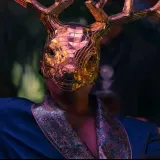Case File #026: The Curse of the Crying Boy Painting
Status: Artifact Anomaly – Recurrent Domestic Fires
Date Filed: September 1985
Last Reviewed: June 2, 2025
Location: United Kingdom – Multiple Cities
Filed Under: Object Curse – Urban Folklore – Media Panic
Access Level: Public Archive – Verified Incidents
Incident Summary
In 1985, British tabloids began reporting on a disturbing pattern: a string of house fires had occurred across various cities, and in each case, a mass-produced painting titled The Crying Boy was found at the scene. Bizarrely, the painting was almost always left untouched by the flames, even when everything else had burned to ashes.
The painting depicted a young boy with dark eyes and a single tear running down his cheek. Sold widely in department stores during the 1970s and '80s, the image was originally considered a kitsch decorative item. But after multiple fire incidents, it gained a far darker reputation — a cursed object capable of causing destruction.
The Fire Brigade Whispers
The initial theory of a cursed painting came from firefighters themselves. Members of the Yorkshire fire brigade began noticing that in numerous domestic fire investigations, a copy of The Crying Boy had been present and had miraculously survived. One firefighter was quoted anonymously in The Sun saying:
“It was uncanny. We’d walk into a home gutted by fire, and there, untouched, would be this boy’s face staring out of a burned wall.”
In September 1985, The Sun ran a sensational headline:
“Blazing Curse of the Crying Boy!”
The story included claims from multiple families that the painting had brought them “bad luck,” “arguments,” or "strange electrical failures" before the fires. Mass panic ensued, and people across the UK began destroying the paintings or demanding their removal.
Public Reaction
Following the article, hundreds of readers contacted The Sun to share their own encounters with the painting. Many said they had experienced inexplicable misfortunes — house fires, car accidents, health issues — shortly after purchasing or hanging the image. Others reported the painting falling off the wall without cause or surviving minor domestic disasters unscathed.
Demand grew for public burnings of the artwork. The Sun even organized a ceremonial destruction event where hundreds of paintings were incinerated in a large bonfire outside its headquarters.
Artist and Origins
The most famous version of the painting is attributed to a little-known Italian artist named Bruno Amadio, who painted under the pseudonym Giovanni Bragolin. Amadio reportedly created dozens of "crying child" portraits after World War II, allegedly inspired by orphans he met during the conflict. These works were later mass-printed and sold worldwide.
There are urban legends surrounding Amadio as well, including one that claims the boy in the painting died in a fire shortly after posing — fueling the curse’s mythology even further. No official record of this death exists.
Investigations and Debunking Attempts
British fire services, under pressure from the public, investigated the phenomenon. A common explanation was offered: the painting was printed on fire-retardant board, and when hung on walls with a wire, the frame might fall face-down during a fire, shielding it from heat and flames.
The UK Fire Service College stated:
“There is no such thing as a cursed painting. The materials and positioning of the artwork account for the survival of the image during some house fires.”
Still, the damage had been done. Rational explanation or not, the legend persisted — especially in online forums and occult communities.
Modern Cultural Impact
To this day, copies of The Crying Boy are traded online, often with warnings attached. Paranormal enthusiasts conduct experiments with the artwork, some documenting alleged poltergeist activity, flickering lights, or mood swings when the painting is in the room.
The painting has appeared in ghost tours, museums of the paranormal, and true horror podcasts. Some people continue to refuse to hang it in their homes, even when purchased as a joke.
In 2017, British YouTuber Bald and Bankrupt documented finding a copy in an abandoned building and refused to take it with him — “just in case.”
Conclusion
Whether a string of coincidences, urban hysteria, or something genuinely unexplainable, The Crying Boy remains one of the most widely feared and controversial objects in modern paranormal lore. It sits at the intersection of art, tragedy, and mass psychological suggestion — forever crying from the shadows of fire-blackened walls.
References
All sources used in this case are listed in the References Archive. Each link corresponds to verified data, public records, or expert documentation.

